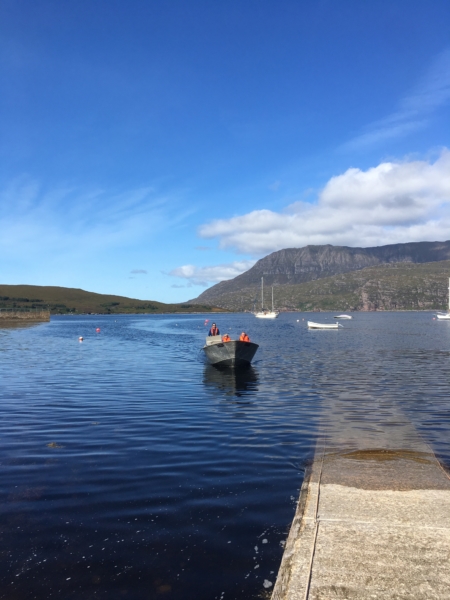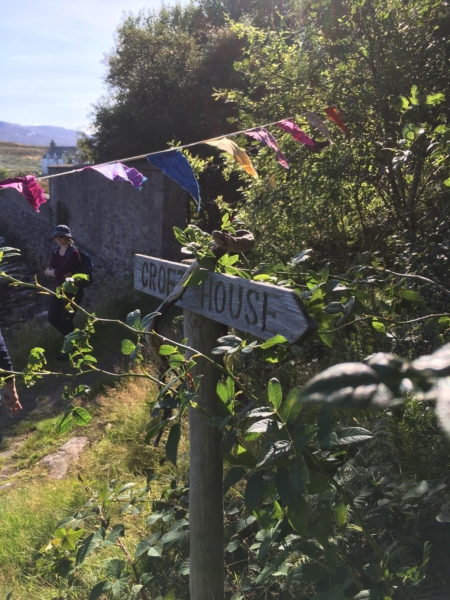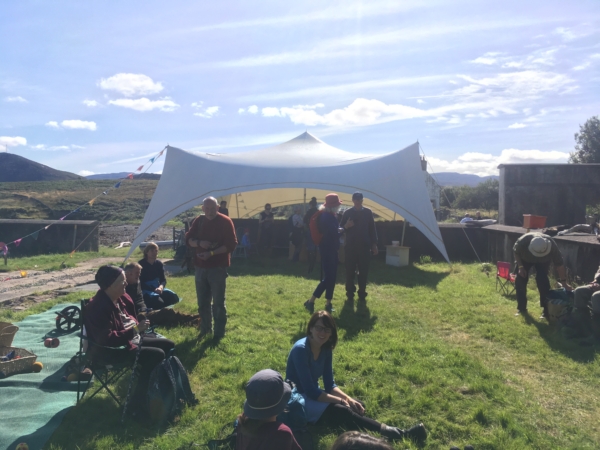Woodland, Willow Warblers and Wild Berries
 This month I was on the West Coast for a first-time visit to sunny Isle Martin – a small uninhabited island north-west of Ullapool, closest of the Summer Isles. We were there to join the island’s Open Day festivities, celebrating twenty years of the island’s community ownership.
This month I was on the West Coast for a first-time visit to sunny Isle Martin – a small uninhabited island north-west of Ullapool, closest of the Summer Isles. We were there to join the island’s Open Day festivities, celebrating twenty years of the island’s community ownership.
The island was gifted to the communities of Lochbroom and Coigach by the RSPB. Formed in 1999, The Isle Martin Trust is now responsible for managing the island, which is open to visitors all year round.
Following a lively discussion at the launch of a new handbook published by the Croft Woodlands Project at The Ceilidh Place in Ullapool that morning, we drove the three miles north to Ardmair on Loch Broom and crossed on the six-person ferry. A warm welcome awaited – bonfire, barbeque, island café, homemade gin, tattie harvesting and a bramble scramble were all on the menu, as well as guided walks and talks.
Author of the new book, Bernard Planterose – who came to live on the island with his family in the 1980s – led a guided walk reflecting on the island’s transformation. When he first arrived, Isle Martin supported almost no trees; today, thanks to an ambitious programme of regeneration, the east side of the island is a flourishing woodland. Here you will find Scots pine, hawthorn, gean, holly, dog rose, ash and oak as well as birch, hazel, rowan, alder and willow. While the local seabird population that Planterose first came to survey has seen a steep decline, the island is now a home to woodland bird species – warblers, spotted flycatcher, tree-creeper, blackcap, redpoll and siskin.
With so many stories of loss the world over, Isle Martin is a story of restoration.
In recent weeks, the world’s gaze has been transfixed on the Amazon rainforest ablaze with thousands of wildfires. Fears surrounding the devastating effects of increased and accelerated deforestation have grown under Bolsonaro, who has vowed to develop the region for farming and mining – ignoring both indigenous rights and international concern over climate breakdown.
Deforestation is one of the world’s greatest problems, causing loss of biodiversity, loss of food security and human displacement. It is estimated to account for 17- 20% of global carbon emissions (more than the sum total of all the cars and trucks on the world’s roads).
Reforestation, then, is one major tool in the world’s response to climate breakdown. A recent study suggests that rapid global effort to plant billions of trees would be ‘overwhelmingly more powerful than all of the other climate change solutions proposed.’
We can readily grasp and understand the consequences of such visible and current destruction in other parts of the world, but what of Scotland’s forests, and what of reforesting Scotland?
In the 10,000 years since the last ice age, a forest covering between 50% and 80% of the entire land surface in Scotland – including the islands – has come and gone. Peak cover of the ‘Caledonian Forest’ was about 5,000 years ago. Today, only around 1% of our native woods remain, and many of the species that once populated these forests are missing – wild boar, lynx, elk, brown bear, wolf.
The World Wars took a heavy toll on the remains of our native forests, and by the mid 20th century, deforestation in Scotland was almost complete. The intensive conifer expansion that followed, along with overgrazing and uncontrolled muirburn, have left native woodlands in a parlous state.
The dissonance between perception, imagination and reality is striking, particularly here in the Highlands, something historian James Hunter writes about in his wonderful book On The Other Side of Sorrow (2014, 1995).
The tourism industry promotes this place as a largely pristine environment – a Romantic ‘wild and majestic’ landscape where wildlife is flourishing in abundance and where human impact is restricted to small patches of fields and villages. The reality is that much of the land is exhausted, the water and soils acidified, wild fish almost exterminated and the wildlife a shadow of its former vitality and potential.
Perceptions of the Highlands suffer from what ecologists call ‘shifting baseline syndrome’ – a concept first applied in marine science to describe the phenomenon whereby each generation accepts a more depleted environment than previous generations as ‘normal.’
The truth is that we live in a largely man-made and deforested landscape – a ‘wet desert’ as ecologist Fraser Darling once described the Highlands (1955).
How many residents – never mind tourists – appreciate the extraordinary deforestation and decline of wildlife experienced over much of the land in only the last 150 years?
A Woodland Culture
The task to ‘reforest Scotland’ is a long and challenging process. It has only really just begun, yet in the space of 100 years, total forest cover has increased from 4 – 5% of the land area to about 19%. That is to be celebrated.
The parallel projects of commercial forestry and native woodland regeneration have followed different silvicultural and ecological paths, which need now to converge.
In my own lifetime – since the 1980s – many reforesting projects and collaborations of a type and scale that were only vaguely imagined at the end of the last century have become reality. Individuals and community groups – representing wide perspectives on the land and its possible uses – have acquired land and have placed woodland restoration at the heart of their renewal efforts. Today, the Reforesting Scotland Journal acts as the main forum for the many strands of social forestry and woodland culture in Scotland, with an annual gathering for interested members (this year in Aberfoyle).
Globally, the movement for reforestation is tied up with arguments for land reform and human rights. Scotland is no different. Earlier this year, Ben Wray for Common Space highlighted the problem of concentrated land ownership as a huge barrier to mass tree planting. Land which might be suitable for reforesting is overwhelmingly in the hands of landed power, with huge estates used for grouse shooting and deer stalking.
As the Revive coalition has highlighted, almost a fifth of the land in Scotland is given over to grouse moors, with devastating ecological effects. Muirburn destroys insects, fungi, bacteria and lichens that drive fundamental processes such as soil formation and nutrient flows, which results in the cumulative nutrient depletion of the whole system. For example, with no insects to eat – a vital source of calcium – birds are unable to lay healthy eggs.
Red deer – now a hundred year problem – represent a major obstacle to reforestation, with overgrazing rendering natural regeneration all but impossible. Deer population is currently concentrated at 15 – 16 deer per km2, when 1 – 3 per km2 would be natural and sustainable. Planterose writes,
“The barrier to the regeneration of soils, diversity of vegetation and woodlands that high deer populations cause (in some but not all areas) is recognised by policy makers, foresters and farmers alike. But the opportunity cost in terms of the alternative economic activity which people have had to forego, is hardly discussed, let alone quantified.”
Reforestation is a direct challenge to the current paradigm of land management. We need to ‘transition from monocultural regimes to more diverse, complex and ultimately more economic agroforestry systems’ where grazing is once more in harmony with vegetation and soils. With the reform of ownership patterns, including community ownership, it is possible envisage a much more diverse pattern of land management practices, vital for ecological restoration, repopulation and rural regeneration.
The symbiosis between the reforesting movement and land reform, along with growing awareness of a global climate emergency, adds further strength to this already persuasive political, social and environmental agenda. This is not a fringe issue. With the sixth mass extinction currently underway, this is vital work.
The Scottish Government recently announced its new Forestry Strategy 2019 – 2029, which sets out to increase woodland cover significantly over the next few decades.
Many believe that the central place of the crofting model in the culture of the Highlands and Islands constitutes an immense force for change. The idea of a ‘woodland croft’ brings together agricultural and woodland interests in this context. The Scottish Crofting Federation is determined to grow and embrace innovative land uses and partnerships, putting a new generation back into close relationship with the land.
There is a wealth of possibilities when woodland provides the matrix within which other land uses can thrive – such as animal husbandry, horticulture or fruit growing:
“We stand in the Highlands and Islands at the beginnings of a land use revolution in terms of ownership and community control. Agroforestry, integration of grazing and woodland systems, diversification of forest products, forest inhabitation and woodland crofting are all part of the paradigm of ‘reforestation’” (Highlands and Islands Woodland Handbook, 2019).
Something that really excites me is the possibility of the restoration of wild berries. The biggest NTFP industries in Europe, Scandinavia and Russia are based on the berry crop, yet this is entirely missing in Scotland as a direct result of grazing and upland management. Sweden averages an annual wild harvest of 485 million kg of wild berries, including blaeberries, lingonberries, and cloudberries – all of which grow wild in the Highlands and Islands. We also have bramble, juniper, sloe, elderberry, rose hip, crab apple and wild cherries.
It is interesting to reflect on the potential of wild berries alone if uncontrolled grazing and muirburn were to magically cease.
Ecological Literacy
If we are to meet the challenges of the future, we need to aspire to a much higher level of ecological literacy.
Ecology is not taught in schools, so where can we learn? And how do we make sure that current and future generations – of crofters, land managers, educators and policy makers – are armed with this vital knowledge?
In recent years, outdoor education has become popular and looks set to grow rapidly. I worry, though, about the burden we are placing on our children. Constant talk of climate change and global environmental destruction can be a source of huge anxiety for many. In order to face the future, we must equip our young people with knowledge, confidence and skills in a tangible real-world context.
Pioneering learning centres like The Shieling Project in Glen Strathfarrar point the way forward, bringing together history, Gaelic culture, language, archaeology, ecology and rural skills to help build new relationships with the land. Project director Sam Harrison reflects:
“We want to see young people excited about working in the countryside, what’s happening here, feeling like there’s a future for them here in the Highlands, that it’s exciting, rather than leaving for the city.”
On Isle Martin, the community trust is committed to further restoration and education in this vein through the building of trails, a field centre and heritage micro museum, giving visitors the chance to study the history of the island, its language and culture, heritage, archaeology, wildlife and ecology.
Such ventures go some way to turning around the processes which ‘have done so much damage both to this area’s people and to its natural environment’ (Hunter, 1995).
“Change is more likely to happen when people reconnect – with each other, and with the biosphere – in rich, real-world contexts… At a certain moment – which is impossible to predict – a tipping point, or phase shift, is reached and the system as a whole changes” (Thackera, 2015).
As we can see from the microcosm of Isle Martin, even incremental acts at the small scale can have wider – even global – significance. It must be wonderful to hear the song of the woodland birds, knowing yours was the hand that planted the tree.



The Forestry Commission’s mono culture needs to change. At least grow a mixture of conifers.
Very interesting piece. There’s a need to clearly distinguish between natural reforestation of native woodland and the planting of deciduous woodland (often single species) enclosed in high deer-proof fences. Grant funding seems to support the latter, not the former. And there’s a real issue of how to protect the historic environment and archaeological sites, many of which have survived since prehistory because the land was first farmed and then grazed. Tree roots do a great deal of damage, and woodland planting can limit access.
As a former Conservator of Forests mainly in East Africa, I could not agree more. I spent many years with the Nature Conservancy (now SNH) arguing for a more enlightened approach to forestry/land use, some of which is now accepted. There are heartening (if rather late) signs – more strength to your elbow.
Great article! Central to land reform is land as s source of public funding. At events on land reform I have recently attended that issue has been missing.
There are various ways of taxing land but we need to have a serious discussion about how each impacts on the other.
Health giving berries and apples indeed and so much more for those of us who have found greatly increased health from a meat free diet.
Great to have more natural woodland and I know many who would be very keen to move into such areas if they were outwith sound of and sight of the shooting industry, who at present drive so many away from our countryside. Woodland crofts are a hugely attractive prospect with a long waiting list , but the crofting agenda in Scotland needs to be moved from the present situation where all grants have been refused for a vegan croft aiming to grow hazelnut trees, because they wont be actively participating in the meat industry. Surely the reverse should be the case, when general consensus is that climate change and health demands we eat less red meat? Marvellous veg growing crofts on for example Skye
The mindset where it’s deemed OK for an introductory talk at an otherwise excellent crofting for newcomers weekend to promote the shooting of extinction threatened woodcock as a possible income booster for anyone with a bit of woodland on their croft has to be ended.
So nice to read your writer , and so many other groups, appreciates how much wildlife can enhance life.
The same syndrome applies to each generation of people accepting there are fewer people in rural areas. Not so, the tide is turning.
Wonderful article & lucky enough to have attended packed out woodland crofting weekend this year
So glad the value of wildlife is being recognised here as was quite horrified to hear hosting the shooting of red listed woodcock , whose numbers have fallen 85% in recent years, listed as a possible means of boosting crofters’ income by introductory speaker at an otherwise mainly excellent new crofters event run by SCF.
At age 88 this article has given me hope for Scotlands survival after 300 years of greed and thoughtless government of the land and the hardworking people of Scotland who are constantly put down by the so called rulers of the so called “Wonderful Union “ One look at the behaviour of the conservative MPs mocking everyone else , laughing, shouting, pointing, must surely have the whole world looking on in horror and those countries who escaped British rule over the centuries must be thanking their lucky stars ! Money isnt everything , looking after the health and happiness of everyone, teaching children that being kind to others not only benefits those they help but makes them feel good too. I wont be here to see this happen but i hope Scots have the courage to break free of the past and make life worth living for everyone who comes to live in this beautiful part of the world .
Very well said, Irene. Thank you.
Thank you to Mairi too, for a very thoughtful and interesting article.
We should certainly be changing land ownership and management in Scotland. I remember grouse beating as a teenager in the 1970’s, and the whole thing seemed utterly ridiculous. A few well-heeled “toffs” blasting away at helpless birds. We can do better than that as a country.
I spoke to someone from Cairn O’Mohr who said they made wines from various kinds of (wild?) berries collected within 50 miles of their Perthshire base.
I suppose we have to look at how forests are represented in our culture. From the dark and dangerous folk tale forests, through the enchanted fantasy forests, to science fiction forest worlds, and beyond. Perhaps a popular army bearing branches will envelop the mad, murderous autocrats in their castle retreats some day, metaphorically speaking.
Planting trees is an activity through which every schoolchild should learn about the lifespans of the natural world. But I guess they also need to appreciate the value of apex predators, even if they nosh on the occasional Bambi too. I was impressed by all that plant communication and defences discovered by scientists that was described in the Royal Christmas Lectures 300 Million Year War. But these have adapted to the kinds of natural mixed woodland described above, not permanently-vulnerable commercial monocultures.
It would be wonderful if these ideas could become part of the mainstream. Ecological literacy is essential, but so is getting your hands dirty. Digging, growing, tending.